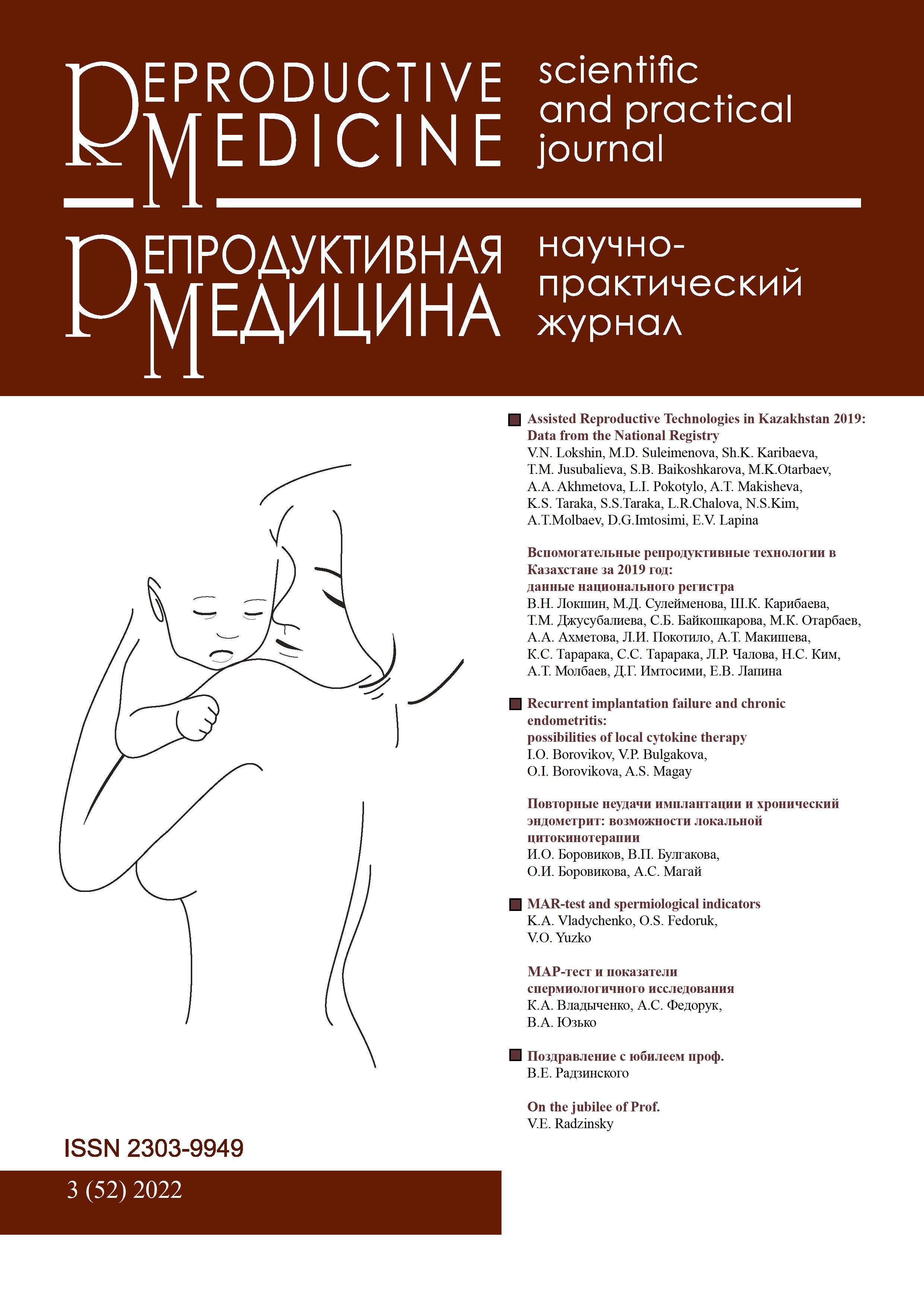MАR-test and spermiological indicators
DOI:
https://doi.org/10.37800/RM.3.2022.74-80Keywords:
MAR test, male infertility, diagnosis, spermogramAbstract
Relevance: Antisperm antibodies are detected in 3-25% of cases in men and women diagnosed with infertility. They can also be diagnosed in 1-10% of healthy fertile men. A high titer of AST is one of the factors of male infertility, which can be "hidden," i. e. not causing symptoms or deterioration of the overall spermogram.
This study aimed to identify the effect of antisperm antibodies on spermiological indicators.
Methods: The retrospective analysis included the test results of 555 men examined at the Medical Center for Infertility Treatment in Chernivtsi, Ukraine. Spermograms were analyzed following the WHO laboratory manual for the examination and processing of human semen, 5th ed., using an inverted microscope Olympus CKX41 in the Makler chamber. The percentage of spermatozoa coated with antisperm antibodies was determined using MAR-test (MAR – mixed antiglobulin reaction).
Results: Only 48.3% of patients could have a suspected relationship between the presence of antisperm antibodies and undertaken surgery, genital infections, and allergy history. Most changes in sperm counts correlated with the percentage of IgG-coated spermatozoa. A negative medium-strength correlation was found between the percentage of Category A spermatozoa and the percentage of IgG-coated spermatozoa. The persistence of IgG in semen was accompanied by a reliable decrease in the morphological quality of sperm. In regression analysis, the trend line showed that the presence of 30% IgG-coated spermatozoa resulted in 100% of pathological spermatozoa in the ejaculate. In 52% of patients, Ig in the ejaculate as an etiological factor could not be established.
Conclusion: The presence of IgG was found to have the greatest impact on spermogram indices. An increase in antisperm antibodies in the semen was found to lead to a significant increase in the percentage of pathological forms and a decrease in sperm motility. Prognostically, 30% or more of IgG-coated spermatozoa will be accompanied by a violation of the morphology of spermatozoa with a probability of 95%.
References
Божедомов В.А., Рохликов И.М., Третьяков А.А. Актуальные вопросы оказания помощи парам с мужским фактором бездетного брака: клинические и организационно-методические аспекты // Андрол. и генит. хирургия. – 2013. – № 4. – С. 7–16. [Bozhedomov V.A., Roxlikov I.M., Tret'yakov A.A. Aktual'nye voprosy okazaniya pomoshhi param s muzhskim faktorom bezdetnogo braka: klinicheskie i organizacionno-metodicheskie aspekty // Androl. i genit. xirurgiya. – 2013. – № 4. – S. 7–16. (in Russ.)]. https://cyberleninka.ru/article/n/aktualnye-voprosy-okazaniya-pomoschi-param-s-muzhskim-faktorom-bezdetnogo-braka-klinicheskie-i-organizatsionno-metodicheskie-aspekty
Божедомов В.А., Гузов И.И., Теодорович О.В. Иммунологические причины бездетного брака (обзор литературы) // Проблемы репродукции. – 2004. – № 6. – С. 57–62. [Bozhedomov V.A., Guzov I.I., Teodorovich O.V. Immunologicheskie prichiny bezdetnogo braka (obzor literatury) // Problemy reprodukcii. – 2004. – № 6. – S. 57–62. (in Russ.)]. http://rusmedserv.com/files/jprobrep/Re_04_06.pdf#page=57
Khan G-A.N., Agarwal D.K., Rabbani T. Antisperm antibody as a cause of immunological infertility in males / // J. Adv. Res. Biol. Sciences. – 2012. – Vol. 4, № 1.– P. 1–4. https://www.researchgate.net/profile/Gouri-Bhoite/publication/317561386_Study_Of_Lipid_Profile_In_Patients_With_Major_Depressive_Disorder/links/5954b988aca2729e74bbe9cd/Study-Of-Lipid-Profile-In-Patients-With-Major-Depressive-Disorder.pdf#page=9
Cui D., Han G., Shang Y., Liu C., Xia L., Li L., Yi S. Antisperm antibodies in infertile men and their effect on semen parameters: a systematic review and meta-analysis // Clin. Chim. Acta.– 2015. – Vol. 444. – Р. 29–36. https://doi.org/10.1016/j.cca.2015.01.033 https://pubmed.ncbi.nlm.nih.gov/25659295/
Vickram A.S., Dhama K., Chakraborty S. Role of Antisperm Antibodies in Infertility, Pregnancy, and Potential for Contraceptive and Antifertility Vaccine Designs: Research Progress and Pioneering Vision // Vaccines.– 2019. – № 7. Р. 116–148. https://doi.org/10.3390/vaccines7030116 https://pubmed.ncbi.nlm.nih.gov/31527552/
Lombardo F., Gandini L., Lenzj A., Dondero F. Antisperm immunity in assisted reproduction // J. Reprod. Immunol. – 2004. – Vol. 62, № 1-2. – p. 101–109. https://doi.org/10.1016/j.jri.2003.08.005 https://pubmed.ncbi.nlm.nih.gov/15288186/
Почерников Д.Г., Герасимов А.М., Гусейнова С.Г. Наумов Н.П. Повышенное содержание антиспермальных антител как предиктор неблагоприятного исхода беременности после применения вспомогательных репродуктивных технологий // Андрол. и генит. хирургия. – 2019. – № 1. – С. 69–74. [Pochernikov D.G., Gerasimov A.M., Gusejnova S.G. Naumov N.P. Povyshennoe soderzhanie antispermal'nyx antitel kak prediktor neblagopriyatnogo isxoda beremennosti posle primeneniya vspomogatel'nyx reproduktivnyx texnologij // Androl. i genit. xirurgiya. – 2019. – № 1. – S. 69–74. (in Russ.)]. https://doi.org/10.17650/2070-9781-2019-20-1-69-74 https://cyberleninka.ru/article/n/povyshennoe-soderzhanie-antispermalnyh-antitel-kak-prediktor-neblagopriyatnogo-ishoda-beremennosti-posle-primeneiya-vspomogatelnyh
Downloads
Published
How to Cite
Issue
Section
License
The articles published in this Journal are licensed under the CC BY-NC-ND 4.0 (Creative Commons Attribution – Non-Commercial – No Derivatives 4.0 International) license, which provides for their non-commercial use only. Under this license, users have the right to copy and distribute the material in copyright but are not permitted to modify or use it for commercial purposes. Full details on the licensing are available at https://creativecommons.org/licenses/by-nc-nd/4.0/.




